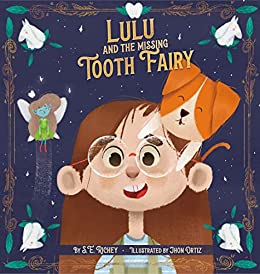Lulu and the Missing Tooth Fairy received a 4+ star review, making it an IndieReader Approved title.
Following find an interview with author S. E. Richey.
What is the name of the book and when was it published?
Lulu and the Missing Tooth Fairy was published on Feb 28th, 2022. The book was originally set to release in mid-January, but since the books were printed overseas, shipping delays forced me to push the release date.
What’s the book’s first line?
“Lulu finally had a wiggly tooth.”
What’s the book about? Give us the “pitch”.
Lulu has lost her first tooth and cannot wait for her first visit from the tooth fairy. Trixie has been training and training and cannot wait to become an official tooth fairy. Everything would be perfect if only Trixie would show up. But mishap after mishap prevent Trixie from reaching Lulu’s destination. Trixie must persevere or Lulu might stop believing in magic. And if Lulu doesn’t place her tooth under the pillow again, Trixie might never become an official Tooth Fairy.
Written in a dual narrative format from the perspective of Lulu and her tooth fairy, the story entertainingly weaves the themes of cause and effect, learning from mistakes, and perseverance. It also introduces children to different tooth collectors and tooth traditions of the world, thus serving as a mirror and a window into other cultures.
What inspired you to write the book? A particular person? An event?
Our family had a terrible tooth fairy, and we cringed whenever our children said, “I have a wiggly tooth!” Forgotten teeth under the pillow, sometimes days in a row, were the constant source of tears in our children and stress for my husband and me. In talking to other parents, I soon found that our family wasn’t the only one struggling with the same tooth fairy troubles. Almost every parent of young children I spoke to, in one way or another, faced challenges with their tooth fairy, and that’s when the idea was born.
Once I developed the plot and came up with reasons for why the tooth fairy might’ve missed a visit, I decided to touch on my own experience as a child losing teeth. I grew up in Puerto Rico, and the tooth collector there is Ratoncito, not the Tooth Fairy. When one of my critique partners reviewed the manuscript, she confused Ratoncito with Mexico’s tooth collector, el Ratón Perez. I had never heard of el Ratón Perez. I only knew of Ratoncito. That got me thinking, “If the United States has the Tooth Fairy, and Puerto Rico has a different tooth collector than other Spanish speaking countries, then what are other tooth collectors of the world I knew nothing about?” I decided then that the story needed to address both what happens when tooth fairies miss a visit and to explore other tooth collectors and traditions.
What’s the main reason someone should really read this book?
Lulu and the Missing Tooth Fairy encompasses all of what I love in a great story: it’s entertaining and humorous with imperfect, relatable, and likeable characters, and by the time the end is reached, the reader will have gained a smidge of understanding of the world around them. If the reader has ever woken up to find their tooth still under their pillow, or if they’ve ever wondered why the tooth fairy didn’t show up, or if the reader has ever had to explain why the tooth fairy didn’t show up, this is the perfect book for them.
What’s the most distinctive thing about the main character? Who-real or fictional-would you say the character reminds you of?
Lulu and Trixie represent every child and their primary caregiver/authority figure. In Lulu, we find a character full of hope and anticipation who believes in magic and trusts that everything will work as it has for others her age and circumstance. And even though Lulu could have stopped believing in magic altogether when the tooth fairy repeatedly failed to appear, she didn’t. She decided to keep the faith.
As far as Trixie goes, she’s also full of hope and anticipation like Lulu, and she’s willing to try new things, even if she’s a little challenged by them (the FPS device, for example). I have a fascination for family history, for those who came before us, and I’m always eager to find out how they dealt with life in general. Therefore, in the end, it was only natural that what pulls Trixie out of her “All is lost” dark moment was to hark back to a lesson given by her very own fairy grandmother. That, and her perseverance as well as Lulu’s willingness to keep the faith, is what brews magic in the end.
When did you first decide to become an author?
March of 2011 is when I decided to pursue writing. Two months prior, my mom died of Multiple Myeloma Cancer at the age of 55, and the reoccurring thought circling in my head was that if I were to die at her age, I only had about 20 years to accomplish all I wanted to accomplish in my life. A type of bucket list emerged, and since writing is one of many things I enjoy doing – and since I had 4 young children to care for – I decided to write a children’s book. I soon realized that to do it well, I needed to learn all I could about the craft of writing. I signed up for a Creative Writing class right away, and there I met another fellow children’s book writer, who not only became my good friend and critique partner but who introduced me to The Society of Children’s Writers and Illustrators. I joined in 2014, and I haven’t stopped writing since.
Is this the first book you’ve written?
No. The first book I ever wrote was a middle-grade novel. Lulu and the Missing Tooth Fairy was the second story I wrote and my very first picture book. At the time, I had been learning to write novels, but because I read many picture books to my children daily, I loved the format, and I wanted to try my hand at writing one. I guess you could say that everything I learned about writing picture books (a there’s a LOT to learn about the format!), I learned it while writing Lulu and the Missing Tooth Fairy.
What do you do for work when you’re not writing?
I’m COO of my household as well as wife and mother of four. My children are older now, and although I no longer change diapers or kiss booboos or hide in the bathroom for a few seconds of peace and quiet, I’m now a chauffeur and late-night therapist, along with everything else that comes with my roles. I get to lend a listening ear, or share in excitement over happy events, or try to mend broken hearts somehow. Sometimes I do a masterful job of being a COO, and sometimes I run my household with the efficiency of a juggler who doesn’t know how to juggle. But that’s my job, and I love it.
How much time do you generally spend on your writing?
I write daily and whenever possible. Sometimes it’s a couple of hours a day. Sometimes it’s just a few minutes. I always make time to write or learn about the craft or revise old manuscripts, etc. My family now understands that if I’ve hit upon a fantastic idea, or I’ve finally worked through a plot hole, etc. I will be unavailable for as long as I need, and they make sure to throw some food at me, so I don’t starve.
What’s the best and the hardest part of being an indie?
The best part of being an indie author is that I’m able to use all the knowledge I’ve acquired in the last eight years when I still hoped to publish traditionally. This collected knowledge is what gave me the confidence to trust my instincts and take the plunge into indie publishing. My goal with Lulu and the Missing Tooth Fairy – and for all my future books – was to produce a book that looked as good or better and read as well as any traditionally published book out there, and I feel I achieved that, all because of everything I’ve learned over the years.
On the other hand, it is this understanding of the traditional publishing industry that has made things difficult for me. Dealing with the stigma that follow indie authors, the idea that one is not truly an author unless one has been traditionally published and that anything outside of that isn’t considered literature, is something I didn’t anticipate. Indies must work extra hard to place a book in a brick-and-mortar bookstore or any store for that matter. And getting libraries to purchase your book? Even more difficult. Oh, it can be done. Indie authors do it every day, so it’s not the difficulty that baffles me. It’s the unfriendliness and lack of courtesy indies sometimes receive. Having to establish credibility at every turn and assure others that I indeed know how to craft a well-plotted story and understand the publishing industry, has been an unexpected challenge.
What’s a great piece of advice that you can share with fellow indie authors?
This journey starts and ends with the book. Without a book, there is no publishing journey, so never stop learning and improving your craft so you can write the best story possible.
Would you go traditional if a publisher came calling? If so, why?
I don’t see that ever happening, but if it did, I would consider traditional publishing for my adult non-fiction. Adults spend their money on what they want to read and there are few, if any, gatekeepers.
However, for my children’s books, I would have to pass. It’s hard enough as it is to get through the proverbial “traditional publishing door” as it is without adding all the gatekeepers who have a say in what and who gets published. On top of that, although children are my target audience, there’s a degree of separation built in since the adults in their lives are the ones purchasing books for them.
Indie publishing has its difficulties, and the learning curve is steep, but it gets easier with each book. And now that I’ve gone through this process twice (my second picture book, TROUBLE WITH TRUFFLES, will release at the end of this year), I’m hooked! Traditional publishing also has its downs. It’s not all roses. Whatever one decides, one must deal with the built-in ups and downs that come with each option. Choosing to publish and market my books how I want, when I want, and on my own terms is an up of indie publishing that sits well with me.
Is there something in particular that motivates you (fame? fortune?)
I write because I cannot help myself. The fact that I get to do what I love is a privilege I don’t take for granted. I write for children in hopes that they will identify somehow with my characters and for the stories to entertain, resonate, or inspire them. If I can achieve some of that even in a small measure, I count it as fame and fortune, and that’s success enough for me.
Which writer, living or dead, do you most admire?
Meg Medina comes to mind. The first time I read one of Meg Medina’s books, I felt like one of my aunts had written it. I’m a huge fan of her work.
I also love Sheila Turnage. Her Three Times Lucky (Mo and Dale Series) are full of humor and heart, my favorite combination.
Which book do you wish you could have written?
Oh, that I could have written Kate Morton’s The Secret Keeper – a historical fiction and murder mystery with an amazing twist at the end!

